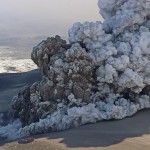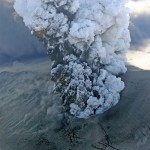While most news report seems to focus on the effect of the ash cloud abroad (we have updated our map of the air traffic disruption across Europe) few international media are focusing on the effect of the ash cloud in the immediate surroundings of the Eyjafjallajökull eruption and on Iceland.
As we reported many times in the past days, life in the Capital Region goes on as usual. We even had some of the first beautiful sunny days of the year, and tourists I saw strolling the streets did not look unhappy at all, especially during the weekend. Of course, you are invited to comment on this post and report your own experience.
But situation is different in the surroundings of the volcano. Some might believe that Iceland is not largely inhabited outside of the Capital Region, but the truth is that hundreds and hundreds of people were affected by the eruption. A lot of these people make a living through the work in the beautiful farms around the eruption area. While the eruption that started in March 20 did not have major effects on people and livestock, it still forced 600 people to leave their homes on the first night. The new eruption, much larger and more devastating because of the huge production of ash and floods, is a different story.

The Farmers Association of Iceland has issued a press release, a couple of days ago, explaining that around 20 farms closer to the volcano were directly affected by the eruption. These farms were evacuated, but farmers and their families are allowed to come and go to perform all necessary daily work in their farm, made much more difficult, fatiguing, and stressful because of the constant ash fall affecting the area. The always excellent IcelandReview wrote a nice article about the daily life in the farms in these days which shows how farmers not only have to take care of their scared and endangered animals, but also need to fight the ash fall directly, cleaning buildings and roofs to avoid the ash from causing major damage and entering the buildings.
The problem with Iceland’s agriculture is that is is based on a fragile equilibrium, as the island is a country of harsh living conditions, where nature reshapes the fields, the mountains, the rivers literally in front of your eyes. It is something to be seen to be believed, but driving through the Icelandic landscape, or even better, stopping your car and walking outside of it, you can sense the very life of the planet flowing everywhere, as ice, earth, wind, and fire. It is in this landscape that farmers have to work, everyday, fighting against these same elements.
This eruption’s worst effects on the farmers are explained in detail by the report of the Farmers Association. The eruption area is source of a substantial percentage of cattle, sheep, horses, dairy production for the whole country. The floods, which had destructive but not catastrophic effects in the past days, remain the biggest fear, especially in the case of a Katla eruption associated with glacial bursts of Jökulhlaup, which we discussed in our article about volcanoes of Iceland. The ash cloud and associated ash fall, rich in fluorine, with its potentially deadly effects on humans and livestock, is the other major problem of the eruption.

Icelanders have lived in profound symbiosis with this heartbreakingly beautiful but unsympathetic landscape for centuries, and their soul, even now that most of the population lives in the super-modern Capital Region, has been shaped by this. In Iceland, nature has the strength of canceling most signs of human life in a matter of years; sometimes, as this eruption shows, in a matter of hours. For anybody coming from countries where huge monuments almost make you feel proud (sometimes, considering the importance culture has in some European countries, with no merit whatsoever), Iceland has to be one of the most humbling places on earth, and one of the most revealing of the frailty of human and animal life on the planet. With the sentiment of this frailty comes also a sense of respect for hard work and the uniqueness of the individual. Sexual differences or race differences have almost no place to be in Iceland. Social cohesion, meant in its most positive sense, is strong here. Sense of justice exists in Iceland, as the extraordinary reaction of the population to the publishing of the Black Report – which is by itself something unique in the capitalistic world we live in – proves.
Coming from a country where sexism is everywhere, where if you are gay you risk of being beaten to death, where a Moroccan father was killed in my own city (a cute, safe city in the center of Italy) a few weeks before my departure just because he dared to talk to the girl behind the counter, where old generations do not want young people to gain any sort of control over their future, where finally the prime minister is still Silvio Berlusconi – whose family owns the most powerful media in Italy, and which just a few days ago criticized for the second time Roberto Saviano because his books about organized crime in Italy ruined the reputation of the country abroad – Iceland and its people are a treasure of inestimable value.
We are close to all the Icelanders, especially to the farmers affected by the eruption, and let’s just hope that this eruption will stop soon. Not that I have any doubt about the country’s will of helping each other to rebuild once the situation goes back to normal.
I think that home land is simply the place where you feel at home. It is still way too soon for me to say that about Iceland – I would not even deserve it yet – but I sure as hell feel more at home here, with volcanoes erupting and floods eating the land, than in the country where I was born.
The incredible photos in this article were shot by Baldvin Hansson while flying above the eruption. Do not hesitate to check his impressive set about the eruption on Flickr.
Thanks for your post and your highly interesting blog in general. your remart about home and iceland reminds me to when i came to Iceland for the first time: from the moment on I left the airplane I felt like having arrived home. Bizarre dream like feeling with all the people around me talking a strange language.
Hey Torsten, thanks. I perfectly understand what you mean – I had the same feeling when we arrived in Seyðisfjörður this February.
And thanks for your comments!